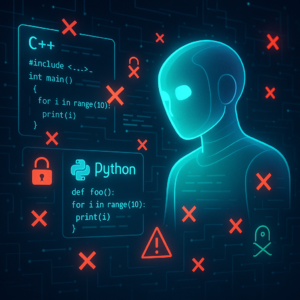Break Free or Stay Secure? Decoding the Jailbreak Defense for Language Models

Break Free or Stay Secure? Decoding the Jailbreak Defense for Language Models
Long gone are the days when AI models simply replied with a shruggy ¯\(ツ)/¯ when they couldn’t compute. Today, these models, often referred to as Large Language Models (LLMs), like GPT-4, LLaMA-2, and Vicuna, have etched themselves firmly into our digital routines. Instead of being befuddled by language requests, LLMs create content, answer complex queries, and even, at times, surprise us with their creativity. But with great power comes great responsibility—and risk. This post introduces an exciting twist in the safeguarding saga of LLMs: the Token Highlighter technique, crafted to outsmart ‘jailbreak prompts’ in AI communications.
What’s a Jailbreak Prompt, Anyway?
Imagine your helpful AI assistant is locked away in a room labeled “Keep it Clean and Safe!” Now imagine someone slipping it a coded message under the door that makes it ignore that label entirely. That, my friends, is a jailbreak prompt—sneaky little commands that convince these language models to deactivate their restrictions. The researchers, Xiaomeng Hu, Pin-Yu Chen, and Tsung-Yi Ho, decided that enough is enough—they’ve formulated an antidote known as Token Highlighter.
The Quest for Safer AI Responses
Large Language Models occupy pivotal roles in applications from virtual assistants to customer service bots. Their integration into everyday digital ecosystems means they must adhere to safety protocols and ethical guidelines. Yet, these models, even prosperous ones like ChatGPT, can sometimes be duped by well-crafted prompts. Think of it as whispering “abracadabra” and having the LLM sing a tune it was meant to forget about!
Enter: Token Highlighter
The Need for a Reliable Bodyguard
In the land of LLMs, a ‘jailbreak’ attempt equates to Houdini slipping out of chains—except in this act, it’s about coaxing the model into spilling secrets or entertaining disruptive inputs. The existing line of defense took various forms but shared flaws: high false positives, interpretability issues, or being too costly.
The Science of Suspect Detection
Token Highlighter introduces the all-seeing eye for the presence of suspect requests. Picture it like a beacon illuminating keywords that trick models into saying “Sure, let me help you with that,” when indeed, the model should be tightening its lips instead.
By analyzing these critical moments—think of it as the LLM’s momentary lapse towards a wrongful affirmative—the Token Highlighter method empowers the model to suppress those mischievous impulses by focusing less on the dubious parts of the query.
How Does Token Highlighter Work?
Decoding the Affirmation Loss
When Token Highlighter comes into play, it doesn’t just gaze at the surface. It calculates what is termed as Affirmation Loss, determining the model’s likelihood of being bamboozled into friendly compliance. By scrutinizing the gradients—essentially the footprints left by language flows—it isolates tokens (words or phrases) making the most disruptive impact.
Soft Removal: The Gentle Nudge
Once these game-changing tokens are identified, one might think the logical next step is to eliminate them outright. Token Highlighter, however, opts for a gentler approach termed Soft Removal—like giving these mischievous tokens a subtle shove, reducing their impact without kicking them out entirely. Think of it as placing a spotlight on suspicious activity and then artfully muting its effects.
Putting It to the Test
In a trial by fire, Token Highlighter stood its ground against six jailbreak attack methods, proving its mettle across popular LLM setups without sacrificing the performance on normal innocent queries. Its brilliance lies in needing just one query pass for computations, making it miles more efficient compared to other defenses.
Real-Life Implications—Beyond the Code
Token Highlighter does more than just add barriers; it demands accountability in AI-augmented interactions. Industries stand to benefit, ensuring that AI assistants remain consistently reliable while keeping misuse firmly in check.
Key Takeaways
-
Jailbreak Attacks & Their Risks: These attacks slyly persuade language models to step outside their ethical boundaries. Think of them as bypassing a safety net.
-
Token Highlighter’s Innovation: A beacon in AI-defense, emphasizing Affirmation Loss to pinpoint when and where a language model’s defenses might be breached. It utilizes a subtle disarming method—Soft Removal—to neutralize risks while minimizing disruptive impacts.
-
Efficiency & Utility: Demonstrates superb performance without taxing the system, effectively blocking harmful responses while continuing to support legitimate user interactions.
-
Broad Impact: Beyond safeguarding AI services, Token Highlighter helps clarify LLM responses, lending greater transparency to how AI navigates queries, useful even for explaining refusals where needed.
In conclusion, the Token Highlighter approach offers more than a barrier—it represents a thoughtful blend of tech wizardry, efficiency, and transparency, promising not just to guard LLMs but also to enhance their reliability in today’s AI-driven world. As you dabble with your favorite AI assistant, knowing these layers of intelligence security might help you sleep a little more soundly.
If you are looking to improve your prompting skills and haven’t already, check out our free Advanced Prompt Engineering course.
This blog post is based on the research article “Token Highlighter: Inspecting and Mitigating Jailbreak Prompts for Large Language Models” by Authors: Xiaomeng Hu, Pin-Yu Chen, Tsung-Yi Ho. You can find the original article here.




